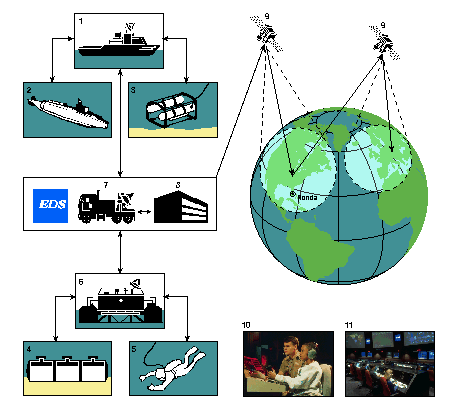JASON VII will originate from various sites in Florida


Telepresence, the unique you-are-there experience of the JASON Project that
lets students experience the thrill of scientific discovery first-hand, is
made possible by integrating many forms of advanced technology. Here's how
it all comes together.

1 - Dr. Ballard will be at the Expedition Control Center on board the S.S.V. Carolyn Choest, the tender ship for the NR-1. The NR-1 and the remotely-operated vehicl (ROV) will operate at this location.
2 - Video, audio and data from the NR-1 are linked to the Expedition Control Center via a fiber-optic cable umbilical cord.
3 - The ROV, connected to the Expedition Control Center by a fiber-optic cable, explores underwater. Signals received from both vehicles are sent via coaxial cable to the television Production Center located nearby. Here the producer selects the sounds and images to be sent to shore. The final signals are then sent to the EDS Carolyn Choest Communications Center via coaxial and copper cables.
4 - Similar to the events on the Carolyn Choest, cameras inside the AQUARIUS allow students to see what it is like to live and work in a submerged environment.
5 - Dr. Jerry Wellington, wearing a bubble helmet, can talk to and be seen by students thousands of miles away.
6 - All video and audio signals from this underwater community travel to the AQUARIUS Production Center via coaxial and fiber-optic cables. Here the producer selects the sounds and images to be sent to shore. The final signals are sent to the EDS AQUARIUS Communications Center via coaxial and copper cables.
7 - At Key Largo, the EDS Expedition Communications Center receives the video, audio, and data signals from the AQUARIUS and Carolyn Choest Communications Centers via microwave technology. Simultaneously, it receives audio and data signals via satellite from the interactive sites across the globe. The diverse signals are integrated and monitored for quality and real-time delivery.
8 - All of the programming options are relayed to the television Production Center at Key Largo for selection of final images. The completed program is then sent back to the EDS Expedition Communications Center to be scrambled and encrypted. Communications Center.
9 - From there, program video, audio, and data are uplinked to a domestic satellite and downlinked to Primary Interactive Network Sites (PINS) across North America, where students experience the thrill of live exploration. For OINS outside North America, the program is uplinked to international satellites for the fianl journey to waiting students.
10 - At the PINS, the video broadcast, phone lines and data networks enable students to see the research as it happens, communicate with the expedition scientists, collect and analyze data, and operate ROVs.
All transmissions, from research sites to PINS, take place in less than half a second.
11 - The EDS Information Management Center in Plano, Texas, provides continuous monitoring of the entire JASON network for quality control and trouble resolution
JASON Project homepage ||
Teachers' Guide ||
Students' Corner ||
Search
![]()
Gene Carl Feldman
Todd Carlo Viola, JASON Foundation for Education (todd@jason.org)